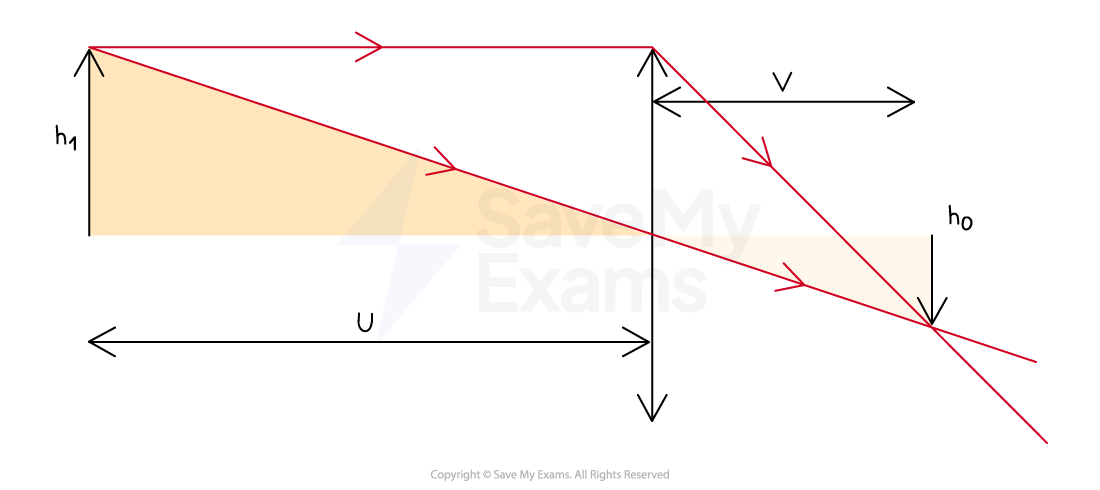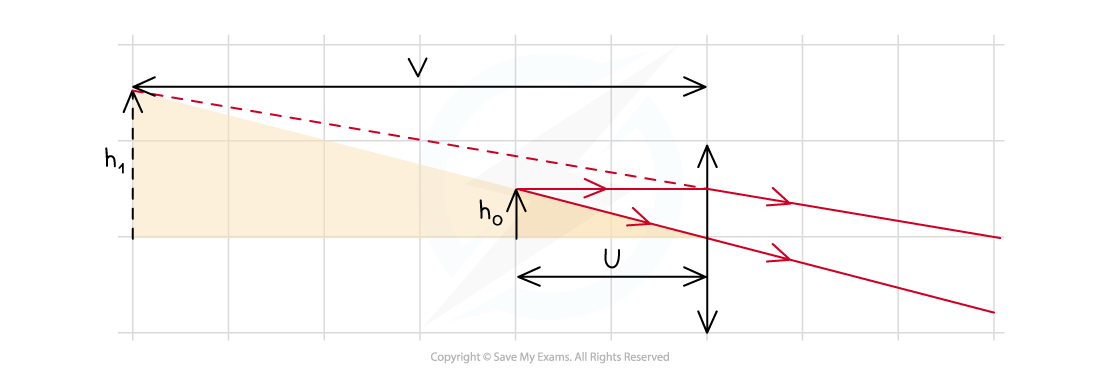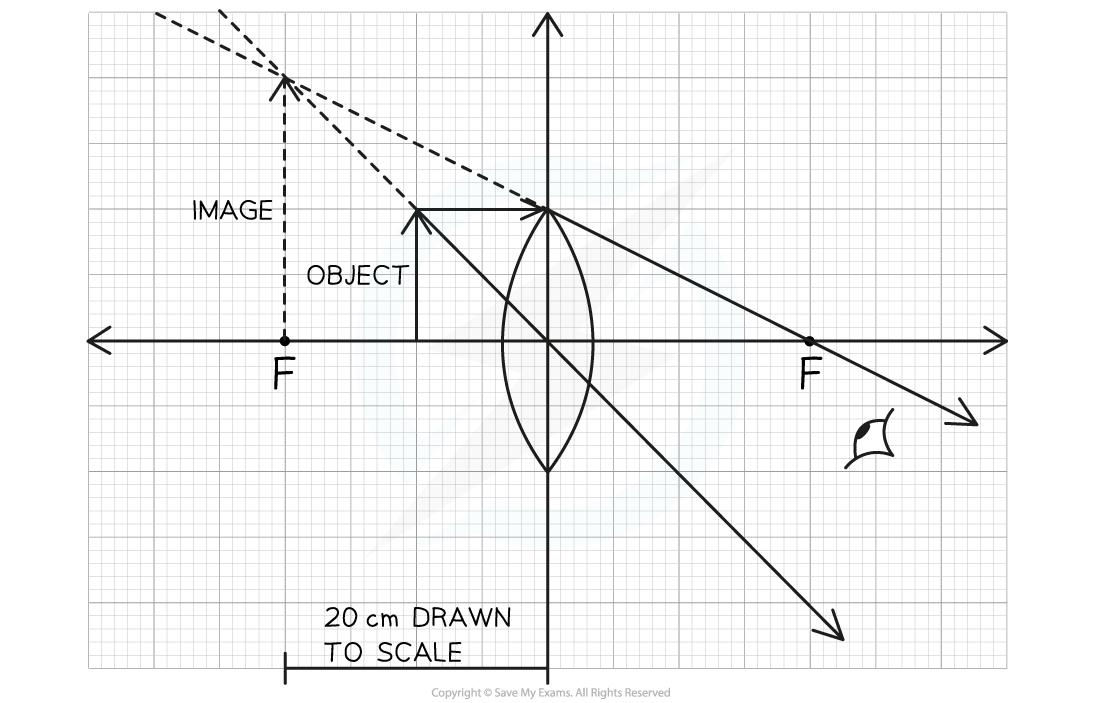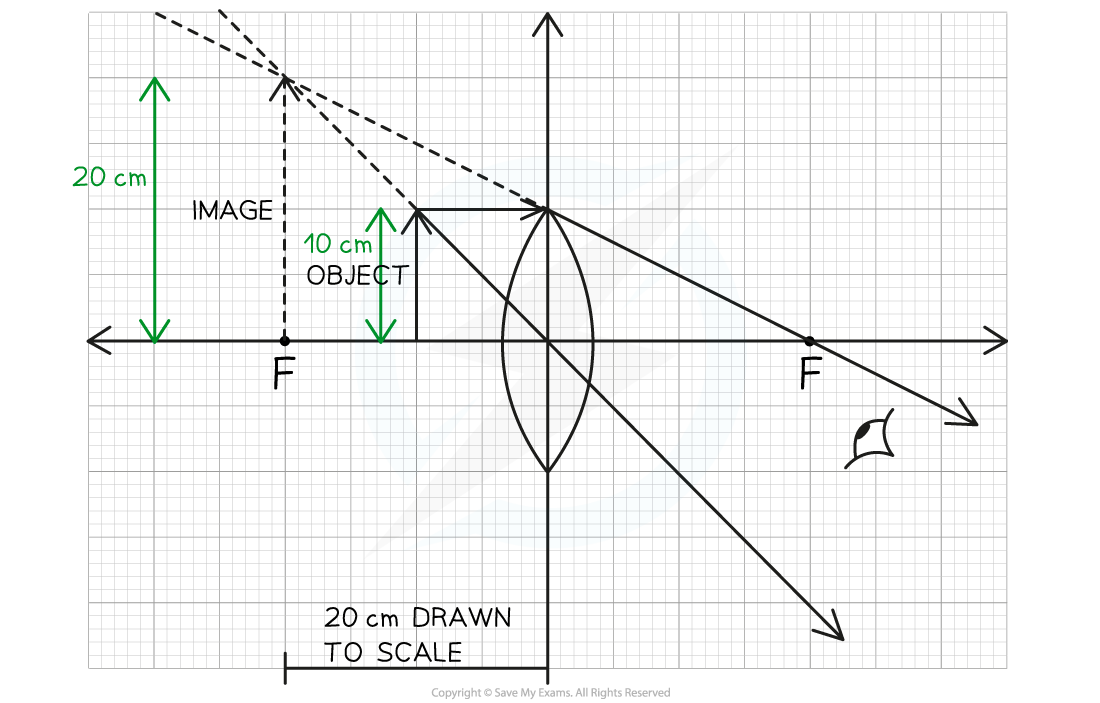Lens Calculations (AQA A Level Physics): Revision Note
Exam code: 7408
Lens Calculations
Power
The power of a lens
is calculated using the following equation:
Where:
P = power (dioptres, D)
f = focal length of the lens (m)
The focal length is measured from the centre of the lens
Power is inversely proportional to focal length
The more powerful the lens, the shorter the focal length
For a diverging (concave) lens, where the focal length is negative, power has a negative value
Worked Example
A diverging lens has a focal length of −1.5 cm.
Calculate the power of the lens.
Answer:
Step 1: Write the known values
Focal length, f = −1.5 cm
Step 2: Convert the focal length into m
1 m = 100 cm
So, −1.5 cm = −1.5 ÷ 100 = −0.015 m
Step 3: Recall the equation for power and focal length
Step 4: Substitute for focal length into the equation
Step 5: Calculate the power of the lens, P
D
Worked Example
A lens is set up between a candle and a screen. All the equipment is arranged perpendicular to the desk. The image of the candle is in focus when the screen is positioned 60 cm from the lens.

Determine the power of the lens.
Answer:
Step 1: Write the known quantities in S.I. units
The image is in focus, so the screen is at the focal point
Focal length,
= 60 cm = 0.6 m
Step 2: Write the equation for power and substitute the values
Step 3: Give the full answer, to correct significant figures and with units
The power of the lens, P = 1.7 D
Examiner Tips and Tricks
The explanations above relate to life in a common-sense way. Stronger, more powerful reading glasses are used by people who have the weakest eyesight. They need lenses to do more of the focusing for them.
The Lens Equation
This equation can be applied to all thin converging and diverging lenses
The equation relates the focal length of the lens to the distances from the lens to the image and the object
Where:
f = focal length (m)
v = image distance from lens (m)
u = object distance from lens (m)
f, v and u do not all have to be in meters but they do have to be in the same units
They are measured from the centre of the lens
Labels of f, u and v on Converging and Diverging Ray Diagrams

Examples of where the lens equation can be used
Remember that:
The values are positive if the image is real
v is negative if the image is virtual
f is negative if the lens is diverging
Worked Example
A student investigates the focal length of a thin lens by using it to project an image onto a screen.
The object is set 50.0 cm from the centre of the lens, and the screen is moved back and forth until the inverted image is sharp. This position is found to be 75.0 cm from the lens.
Determine the focal length of the lens.
Answer:
Step 1: Write the known values
Distance from object to lens, u = 50.0 cm
Distance from image to lens, v = 75.0 cm
Step 2: Write the equation and substitute in the values
f = 30 cm
Examiner Tips and Tricks
It is easy to forget the last step in a calculation like this one. Remember that you are calculating not f, and that you need to take the reciprocal of your answer.
Linear Magnification
Magnification as a Ratio of Heights
Magnification means how much larger the image is than the object
This is the ratio of the image/object height
Where:
m = magnification
hi = image height (m)
ho = object height (m)
Magnification as a Ratio of Distances
A diagram of an object and its real image will produce similar triangles
Therefore, the ratio of magnification is also represented by comparing the distance from the lens to the object and the image
Real Image Magnification as a Ratio of Image and Object Distances

The ratio of object distance u to image distance v is the same as object height h1 to image height h0 for a real image
This also works for virtual images
Virtual Image Magnification as a Ratio of Image and Object Distances

The ratio of object distance u to image distance v is the same as object height h1 to image height h0 for a virtual image
Where:
m = magnification
v = distance from lens to image (m)
u = distance from lens to object (m)
Since magnification is a ratio, it has no units
Worked Example
A magnifying glass has a focal length of 15 cm. It is held 5 cm away from a component which is being examined.
Determine the magnification of the image.
Answer:
Step 1: Write the known values
Focal length, f = 15 cm
Distance between object and lens, u = 5 cm
Step 2: Use the lens formula and rearrange to make v the subject
The negative sign indicates a virtual image (expected for a magnifying glass) and is ignored for the next step
Step 3: Use the magnification formula to find the magnification of the image
Worked Example
A person sees an image from a magnifying glass.

Calculate the magnification of this image. Clearly show your working on the diagram.
Answer:

Step 1: Measure the height of the object from the scale
The object is 10 cm
Step 2: Measure the height of image from the scale
The image is 20 cm
Step 3: Substitute values into the magnification equation
Examiner Tips and Tricks
The most common mistake with magnification calculations is to get the formula upside down.
Do a 'sanity check' by looking at the answer to make sure that magnified objects have got bigger (m > 1) and diminished ones smaller (m < 1).
Since we are working with ratios (so the units get cancelled out) this is one of those rare times when you don't need to convert everything to SI units, but do check that your units are all the same - for example all distances in cm.

Unlock more, it's free!
Did this page help you?